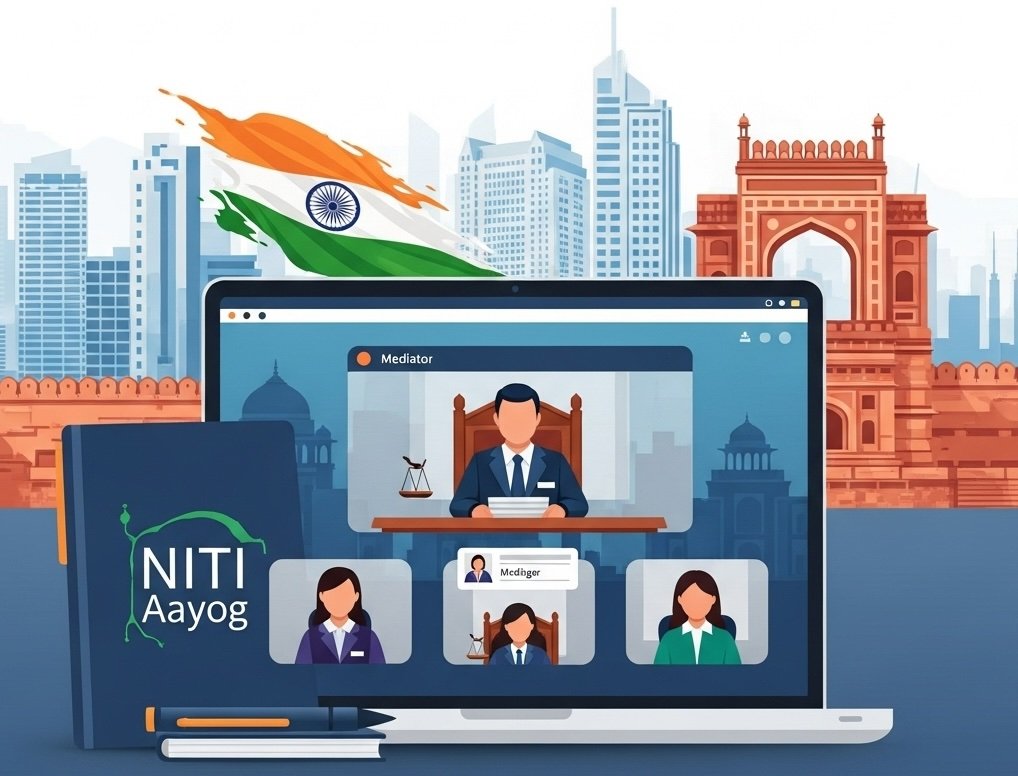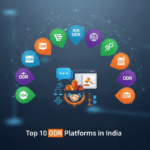
India’s justice system faces unprecedented challenges with more than 40 million pending cases, resulting in years-long delays and constrained access to justice. The judiciary’s immense caseload, combined with the surge in digital transactions and consumerism, urgently demands innovative, accessible, and efficient dispute resolution mechanisms. Online Dispute Resolution (ODR) has emerged as a revolutionary solution, using technology to enable faster, cost-effective resolution outside traditional courtroom settings. Central to this transformation is NITI Aayog, the Government of India’s premier policy think tank. Its 2023 policy paper, “Designing the Future of Dispute Resolution: The ODR Policy Plan for India,” presents a comprehensive blueprint for integrating technology into India’s justice ecosystem, setting the stage for a digital justice revolution.
What is Online Dispute Resolution?
ODR is the digital evolution of Alternative Dispute Resolution (ADR), employing digital platforms for mediation, arbitration, negotiation, and conciliation, using tools like video conferencing, AI-assisted decision-making, e-signatures, and secure document exchanges. It caters to disputes in civil, commercial, consumer, family, labor, and employment domains. ODR’s core advantages include rapid resolution, lower costs, increased accessibility—especially for rural and marginalized groups—transparency through record keeping, and flexible asynchronous communication. It thus aligns well with India’s digital-first governance and inclusive growth objectives.
NITI Aayog’s Vision for Justice Modernization
NITI Aayog’s ODR policy is an outcome of extensive consultation with the judiciary, government agencies, legal experts, tech innovators, and consumer forums. Chaired by Justice (Retd.) AK Sikri, the committee advocates mainstreaming ODR nationally by emphasizing dispute avoidance, swift resolution, and digital enforceability. The report underscores a cultural shift where courts become efficient justice delivery services rather than overloaded physical infrastructures.
Core Pillars
• Dispute Prevention: Encouraging preemptive dispute clauses in contracts empowered by ODR.
• Dispute Resolution: Promoting ODR for low-value and high-volume disputes, commercial sectors, consumer grievances, and government complaints.
• Dispute Enforcement: Streamlining online enforcement mechanisms for digital arbitration and conciliation awards.
Institutional Integration
Mandating ODR adoption by courts, regulators (RBI, SEBI, IRDAI), MSMEs, startups, and government bodies, the policy envisions a digitized multi-tier justice ecosystem.
Case Studies of India’s ODR Journey
- The Framework Pilots and E-Lok Adalats
The Ministry of Law & Justice initiated virtual Lok Adalats during the COVID-19 pandemic lockdown which resolved over 10 million disputes remotely. This successful experimentation proved ODR’s scalability and acceptance across socio-economic strata, from petty property disputes to consumer grievances. - PayPal’s Global ODR System & Indian Legal Parallels
PayPal’s automated negotiation platform settles over 60 million buyer-seller disputes annually, leveraging AI algorithms that match offers and counteroffers quickly. Inspired by such global models, Indian platforms like SAMA and Presolv360 incorporate AI-driven negotiation and dispute triage, creating a seamless resolution experience domestically. - Landmark Judicial Recognitions
• Trimex International FZE Ltd. v. Vedanta Aluminium Ltd. (2010): The Supreme Court upheld the legality of online arbitration agreements, noting email-based agreements satisfy IT Act and Evidence Act requirements.
• Shakti Bhog Foods Ltd. v. Kola Shipping Ltd. (2009): Validated electronic communications as binding arbitration records.
• Meters & Instruments Pvt. Ltd. v. Kanchan Mehta (2017): Encouraged use of technology for paperless courts and online case categorization.
• SBI Cards v. Rohidas Jadhav (2018): Recognized WhatsApp-delivered litigation notices as valid, reflecting evolving digital interaction norms.
Impact of NITI Aayog’s Policy on ODR Growth in India
Judicial and Executive Advancements
Courts actively embraced virtual hearing technology accelerated by the pandemic, with Supreme Court and High Courts directing disputes to ODR mechanisms as a cost-effective means to ease judicial burdens. The RBI and SEBI have used ODR frameworks to settle banking and securities disputes rapidly. The MSME Ministry’s SAMADHAAN portal exemplifies government-backed digital dispute redressal.
Infrastructure & Digital Literacy Initiatives
The policy’s emphasis on IndiaStack, DigiLocker, and BharatNet ensures foundational infrastructure for ODR expansion. Digital literacy drives and vernacular interfaces make ODR accessible to traditionally excluded demographics.
Capacity Building
Standardized training programs for mediators, arbitrators, judicial officers, and legal aid volunteers ensure quality and ethical ODR implementation. The policy calls for creating professional accreditation and continuous education for dispute professionals.
Regulatory Modernization
To safeguard users without stifling innovation, a recommended self-regulatory organization (SRO) model and legal reforms seek to harmonize ODR processes within India’s legal framework, including stricter data privacy protections and enforceable digital contract norms.
Future Growth and Innovation
NITI Aayog encourages integration of AI, blockchain, natural language processing, and mobile technologies to make ODR faster, more transparent, and user-friendly. AI assists in dispute triaging and drafting, blockchain provides immutable evidence chains, and mobile apps expand reach in rural and underserved areas.
Socio-Economic Benefits
• Substantial reduction of court backlogs.
• Faster commercial contract enforcement improves investment climate.
• Consumers get quicker grievance redressal at lower cost.
• Rural populations can participate without physical or financial barriers, promoting equity.
• Digitally integrated justice boosts global perceptions of India’s legal system.
International Best Practices
ODR models from abroad provide valuable lessons:
• EU ODR Portal: Efficient cross-border consumer dispute portal.
• British Columbia Civil Resolution Tribunal: Fully virtual tribunal for small claims.
• Singapore’s Mediation Centres: Supported by government-subsidized ODR services.
• UAE’s Online Court: Complete digital adjudication system.
Conclusion
NITI Aayog’s ODR Policy Plan is an ambitious and necessary blueprint redefining justice delivery in India. Through technology, capacity building, regulatory reform, and inclusive infrastructure, it offers a future where justice is fast, affordable, and accessible to all. Its recommendations empower courts, governments, businesses, and citizens to collectively build a resilient, equitable, and tech-enabled justice ecosystem, setting India on the path to becoming a global leader in digital dispute resolution.


